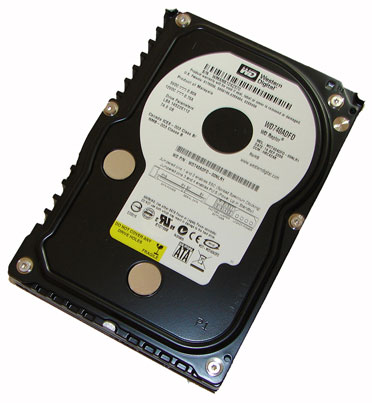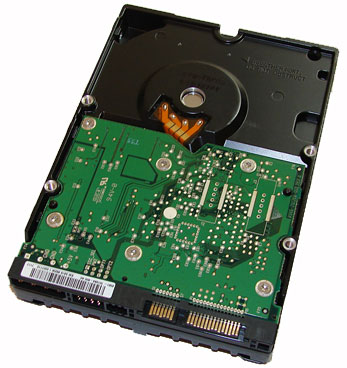Western Digital WD740ADFD: Bottled Lightning
by Gary Key on February 7, 2007 3:30 AM EST- Posted in
- Storage
Feature Set: WD Raptor WD740ADFD

The external design of the Western Digital Raptor series is the same as the majority of their SE16 and RE2 offerings. The familiar all black casing gives the drive a Darth Vader presence in the system as does its performance. The drive is based on the industry standard 3.5" form factor platform with pertinent part number and warranty information embossed on a white sticker on the top of the casing.

The current Raptor family ships with the SATA data and power connectors along with a 4-pin Molex power connector designed for use with older ATX power supplies. To the left of the SATA data and power connectors is an eight-pin jumper block. This jumper block can be utilized to implement spread spectrum clocking or power up in stand by operation. Our test drive was manufactured in Malaysia.
Hard Disk Test Comparison and Features
The Western Digital WD740ADFD drive we are reviewing today will be compared directly against the WD1500ADFD and WD740GD-00FLC0 drive in our limited benchmark test suite. We have also included the results of drives from our previous articles and will provide additional reviews of drives up to 500GB capacity ranges in the near future. The Western Digital Raptor drives ship with a five year warranty.
Hardware Setup
Our current test bed reflects changes in the marketplace over the past six months. Based upon the continuing proliferation of dual core processors and future roadmaps from AMD and Intel signifying the end of the single core processor on the desktop in the near future, we settled on an AMD Opteron 170. This change will also allow us to expand our real world multitasking benchmarks in the near future while providing a stable platform for the next six months. We are currently conducting preliminary benchmark testing under Vista with both 2GB and 4GB memory configurations. We will switch to Vista once the driver situation matures and our benchmark results are repeatable.

The external design of the Western Digital Raptor series is the same as the majority of their SE16 and RE2 offerings. The familiar all black casing gives the drive a Darth Vader presence in the system as does its performance. The drive is based on the industry standard 3.5" form factor platform with pertinent part number and warranty information embossed on a white sticker on the top of the casing.

The current Raptor family ships with the SATA data and power connectors along with a 4-pin Molex power connector designed for use with older ATX power supplies. To the left of the SATA data and power connectors is an eight-pin jumper block. This jumper block can be utilized to implement spread spectrum clocking or power up in stand by operation. Our test drive was manufactured in Malaysia.
Hard Disk Test Comparison and Features
| Hard Drive Specifications | ||
| WD Raptor 150GB WD1500ADFD |
WD Raptor 74GB WD740ADFD |
|
| Stated Capacity: | 150GB | 74GB |
| OS Capacity: | 139.73 GB | 69.24 GB |
| Interface: | SATA 1.5Gb/s | SATA 1.5Gb/s |
| Rotational Speed: | 10,000 RPM | 10,000 RPM |
| Cache Size: | 16 MB | 16 MB |
| Average Latency: | 2.99 ms (nominal) | 2.99 ms (nominal) |
| Read Seek Time: | 4.6 ms | 4.6 ms |
| Number of Heads: | 4 | 2 |
| Number of Platters: | 2 | 1 |
| Power Draw Idle / Load: |
9.19W / 10.02W | 9.19W / 10.02W |
| Command Queuing: | Native Command Queuing | Native Command Queuing |
| Warranty: | 5 Year - Retail or OEM | 5 Year - Retail or OEM |
The Western Digital WD740ADFD drive we are reviewing today will be compared directly against the WD1500ADFD and WD740GD-00FLC0 drive in our limited benchmark test suite. We have also included the results of drives from our previous articles and will provide additional reviews of drives up to 500GB capacity ranges in the near future. The Western Digital Raptor drives ship with a five year warranty.
Hardware Setup
| Storage Test Bed Playback of iPeak Trace Files and Test Application Results |
|
| Processor: | AMD Opteron 170 (2.0GHz 2x1MB) |
| RAM: | 2 x 1GB Corsair 3500LL PRO Settings - DDR400 at (2.5-3-3-7 1T) |
| OS Hard Drive: | 1 x Maxtor MaXLine III 7L300S0 300GB 7200 RPM SATA 16MB |
| System Platform Drivers: | NVIDIA Platform Driver - 6.85 |
| Video Card: | 1 x Asus 7600GS (PCI Express) |
| Video Drivers: | NVIDIA nForce 84.21 WHQL |
| Optical Drive: | BenQ DW1640 |
| Cooling: | Zalman CNPS9500 |
| Power Supply: | OCZ GameXStream 700W |
| Case: | Gigabyte 3D Aurora |
| Operating System: | Windows XP Professional SP2 |
| Motherboard: | MSI K8N Diamond Plus |
Our current test bed reflects changes in the marketplace over the past six months. Based upon the continuing proliferation of dual core processors and future roadmaps from AMD and Intel signifying the end of the single core processor on the desktop in the near future, we settled on an AMD Opteron 170. This change will also allow us to expand our real world multitasking benchmarks in the near future while providing a stable platform for the next six months. We are currently conducting preliminary benchmark testing under Vista with both 2GB and 4GB memory configurations. We will switch to Vista once the driver situation matures and our benchmark results are repeatable.










26 Comments
View All Comments
Genx87 - Wednesday, February 7, 2007 - link
Once you have one you cant go back :DThey are wonderful drives. The capacity issue isnt a big deal unless you are opting for the 36GB version. I havent had a need for excessive amounts of capacity since I built my sever a couple of years ago.
I built a server with a pair of the 36GBs with a 500GB array behind it for storage. It is a very nice step up from the pair of 80GB 7200 rpm drives in there before.
aka1nas - Wednesday, February 7, 2007 - link
They definately make great OS/Applications drives if you back them up with a bigger drive for bulk storage.Genx87 - Wednesday, February 7, 2007 - link
oops forgot to mention my machine at home has the newest 74GB raptor in it. Which is an upgrade from the 1st run 74GB raptor in my old machine.Blazing fast, as usual.
Muzzy - Wednesday, February 7, 2007 - link
"Of course, if you are into benchmarking or run a lot of disk intensive applications, then a pair of Raptors in RAID 0 will be even better."Um, aren't you guys contradicting yourself here? In July 1st, 2004 article about Raptor drives in RAID-0, you stated "If you haven't gotten the hint by now, we'll spell it out for you: there is no place, and no need for a RAID-0 array on a desktop computer." I love my 150GB Raptor despite the noise, don't get me wrong. Really do wish though that other company would give WD some competition in this category. $190 for 150GB??
JarredWalton - Wednesday, February 7, 2007 - link
Most people don't really care about running benchmarks for bragging rights, and most desktop users do not "run a lot of disk intensive applications". We don't think RAID 0 is even remotely necessary for 99% of people, but there are still benchmarks where it is obviously faster. If you have BitTorrent running in the background with other networked computers streaming data off of the same drive and you start to run games that load off of the same drive, yes, RAID 0 will clearly outperform a single drive. That's more of a server/workstation workload, which is why we say that RAID 0 on a desktop computer isn't needed.Axbattler - Thursday, February 8, 2007 - link
*Ponders*Where RAID-0 excels is in STR performance. Loading of applications that benefit from STR (e.g. XP), copying a large massive file, working with a large massive file (video editing) etc. are applications where you will see a significant gain with RAID-0.
RAID-0 may well be faster than a single drive identical drive in most applications (you do pay slightly in access time, but the gain from STR can probably offset it more often than not).. But how about a well two individual drives in a reasonably configured system? I am not convinced that in the scenario that you've described (which, I do not believe reflects the nature of the workload in a server in the first place), that you are necessarily better off with RAID-0 than two individual drives. I would rather have one drive running the game, and the other doing the streaming/torrenting. Game loading time is not exactly where I've seen RAID-0 shine the most (and once the game is running, you'll pretty much get no gain from RAID-0).
JarredWalton - Thursday, February 8, 2007 - link
Then carry it a bit further. Basically, I'm saying that if you generate enough concurrent HDD accesses, RAID 0 will outperform single drives. You might get better performance from two drives without RAID 0, but then you need to worry about having separate volumes and what happens if most of the accesses start to target a single drive. Basically, RAID 0 can be faster than an individual drive, but this mostly occurs in unrealistic situations, as you point out. RAID 0 mostly seems to be for bragging rights, and I certainly don't recommend it.lemonadesoda - Wednesday, February 7, 2007 - link
Most Raptorers (the people who love and install them) typically choose a dual drive RAID setup for ultimate HDD performance.However, seeing the (very close) performance of Seagate 7200.10, I would be very interested to see Raptors in RAID vs 7200.10 in RAID.
Would the performance gap INCREASE or DECREASE in such a configuration?
Le Québécois - Wednesday, February 7, 2007 - link
It's nice to see my WD1500ADFD is still the top gaming drive on the market. Still something has been bothering me for some time now.I've always found intriguing that my Raptor temperature is about 40% lower (idle and under load) than the one you post on every HDD articles. I have a 80mm Antec front fan but still the temperature is 40% lower, not 25%.
What's the room temperature? You always post the base dB of the room but I don't remember ever seeing the temperature.
jabber - Wednesday, February 7, 2007 - link
Indeed, I bought one of these 74Gb Raptors a few weeks ago and it never gets more than slightly warm. Certainly doesnt warrant an 80mm fan blasting on it.I do recommend the WD Secure SATA cable though. Great bit of kit. How the standard SATA cable connection setup got approved I'll never know.
The niggle I have is that 74Gb is too small? I have a full XP install, several apps and games (BF2/Total War etc. etc. and its still got plenty of space. Why would you bother cluttering up your main system HD with non-essential stuff like media files? Just get a cheap 400Gb+ for that sort of thing where performance isnt an issue.